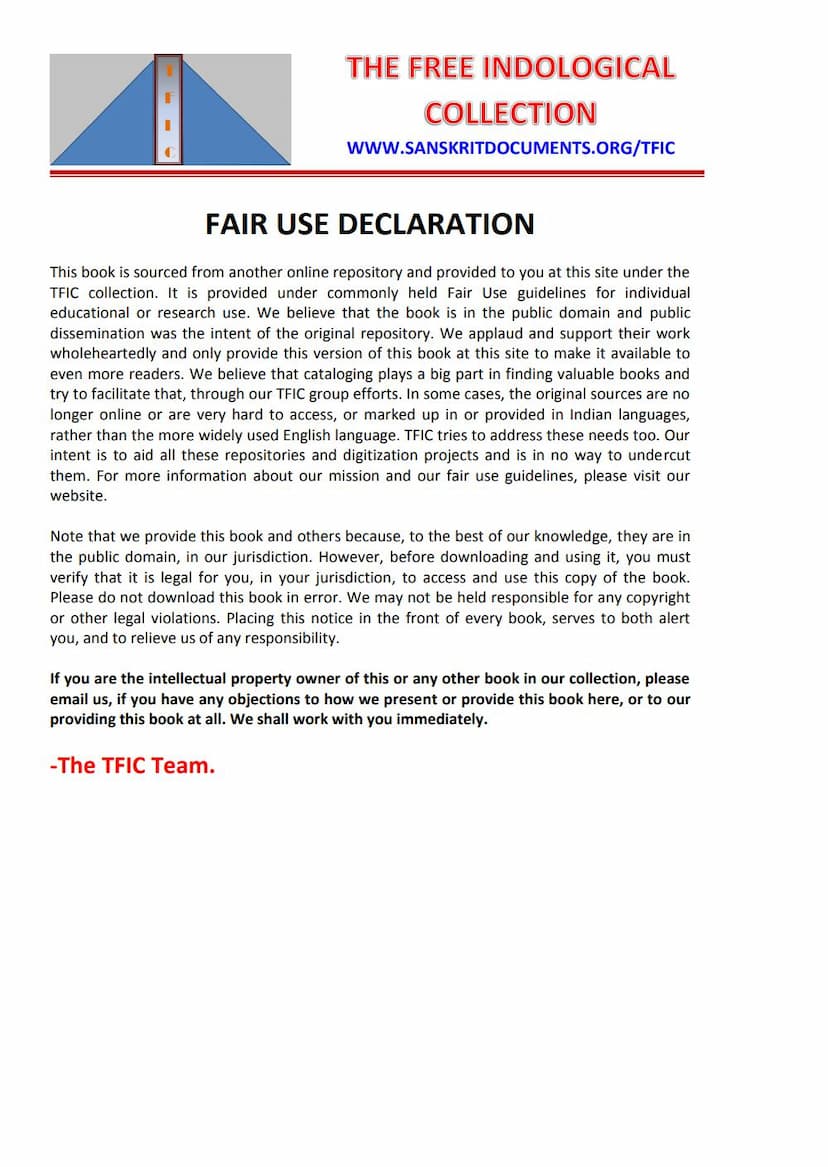Aadikal Ka Hindi Jain Sahitya
Added to library: September 1, 2025

Summary
This is a comprehensive summary of the book "Aadikal ka Hindi Jain Sahitya" by Harishankar Sharma, based on the provided text, focusing on the content and arguments presented in the initial pages related to the early period of Hindi Jain literature.
Book Title: Aadikal ka Hindi Jain Sahitya (Hindi Jain Literature of the Early Period) Author: Harishankar Sharma 'Harish' Publisher: Harishankar Sharma Period Covered: c. 650 - 1450 CE
Overall Objective: The book aims to present a detailed study of Jain literature in Hindi during the early period (Aadikal), which the author believes has been unjustly neglected or misrepresented by previous literary historians like Acharya Ramchandra Shukla. Sharma's core argument is that the rich and diverse Jain literary output of this era, spanning approximately 800 years, deserves proper recognition as a significant stream within the broader history of Hindi literature.
Author's Motivation and Critique of Previous Scholarship:
- Disappointment with Existing Histories: Harishankar Sharma expresses his disappointment with existing Hindi literary histories, particularly those by Ramchandra Shukla (who termed this period "Veergatha Kal" or Ballad Age). Sharma feels that Shukla's assessment of this period was incomplete and unfair, especially regarding the Jain contribution.
- Shukla's Exclusionary Approach: Sharma highlights that Shukla's methodology largely excluded religious and sectarian literature, dismissing it as mere "communal teachings" rather than true literature. This led to the neglect of the vast body of Jain poetry, which, according to Sharma, possessed significant literary merit, natural emotions, and depth.
- Challenging the "Veergatha Kal" Label: Sharma contests Shukla's "Veergatha Kal" designation, arguing that many of the works cited by Shukla as exemplary of this period have since been proven to be either apocryphal or from a later era. He cites scholars like Dr. Prithvinath Kamal Kulshreshtha, Dr. Ramkumar Verma, and Mahapandit Rahul Sankrityayan, who also questioned the prevailing narrative.
- The Abundance of Jain Literature: Sharma firmly believes that given the strength and variety of Apabhramsha literature (which preceded and influenced early Hindi), the subsequent period couldn't have been as "impoverished" as portrayed by some historians. The wealth of available Jain Apabhramsha and early Hindi works contradicts this view.
- Inspiration from Other Scholars: Sharma credits Rahul Sankrityayan's work on Apabhramsha literature (which he renamed "Purani Hindi") and Dr. Hazari Prasad Dwivedi's "Hindi Sahitya ka Aadikal" for their insights that challenged the prevailing dismissive attitudes towards religiously inspired literature, provided it contained literary merit and resonated with human experience. Dwivedi's argument that religious themes can be powerful motivators for literature is particularly influential.
- Personal Drive: Sharma's personal experience of seeking these "lost" or "ignored" literary traditions fueled his research, creating an "insatiable thirst" to uncover and analyze early Hindi Jain literature.
Key Themes and Arguments:
- Re-evaluation of the "Aadikal" (Early Period): Sharma proposes that the term "Aadikal" is more appropriate than "Veergatha Kal" because it encompasses the foundational nature of the literature produced, including the works of Siddhas, Nath-yogis, Jain poets, and others.
- Inclusivity of Religious Literature: A central argument is that religious literature, when it possesses literary merit, artistic value, and reflects natural human sentiments, should not be excluded from the mainstream of literary history. Jain literature, even with its religious inspiration, often achieved high literary standards.
- The Richness of Jain Apabhramsha and Early Hindi: Sharma emphasizes the "viplav" (abundance) of Jain literature written in Apabhramsha and its transition into early Hindi. Poets like Svayambhu, Pushpadanta, Dhanpal, and others are highlighted as significant figures whose works are not merely religious texts but substantial literary achievements.
- Addressing Scholarly Gaps: Sharma acknowledges the difficulties in accessing and analyzing materials, particularly manuscripts preserved in Jain Bhandars in Gujarat and Rajasthan. He credits scholars like Shri Agarachand Nahata and Dr. Hiralal Jain for their work and support in accessing these materials.
- Structure of the Book: The book is structured to provide a systematic analysis, divided into parts and chapters covering:
- Introduction: Defining the scope and methodology.
- Historical Context: Discussing the political, religious, social, economic, and cultural conditions of the period.
- Jain Principles: Explaining key Jain philosophical tenets relevant to literature.
- Apabhramsha Literature: Analyzing its characteristics and influence.
- Non-Jain (Secular) Literature: Examining contemporary secular literature for comparative analysis.
- Major Jain Literary Traditions: Detailed analysis of Ras, Fagu, Chaupai, Charit, Vivaha, Sandhi, Pwado, etc.
- Specific Works: In-depth study of significant poems and prose works like Bharateshwar Bahubali Ras, Chandanbala Ras, Nemianth Ras, Pwado, etc.
- Metrical Analysis: Examining the prevalent meters.
- Language Analysis: Focusing on the evolution of language.
- Contribution to Hindi Literature: Highlighting the unique contributions of Jain literature to the development of Hindi.
Methodology and Challenges:
- Manuscript Research: The research heavily relies on studying manuscripts from various Jain Bhandars, which presented significant challenges in terms of accessibility, preservation, and analysis.
- Interdisciplinary Approach: The study aims to connect literary analysis with historical, social, and philosophical contexts.
- Correcting Misconceptions: A major goal is to correct the historical narrative that marginalizes Jain literature by demonstrating its literary value, diversity, and impact.
Conclusion (from the introductory pages): Harishankar Sharma's work is a testament to his dedication to uncovering and celebrating the significant, yet often overlooked, contribution of Jain literature to the early stages of Hindi literary development. He aims to rectify previous oversights and establish a more accurate and inclusive understanding of the "Aadikal" by highlighting the rich tapestry of early Hindi Jain literary works.